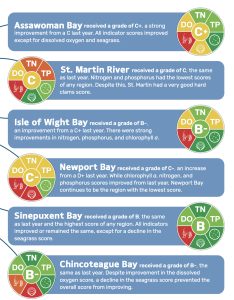The annual Maryland Coastal Bays Program report card recently released a score that reveals the health of the Eastern Shore waterways has improved since last year.

The pictured chart offers a visual summary of coastal bay health indicators, with the insufficient presence of sea grass and hard clams dragging down the overall score.
Graphic courtesy MCB
By Tara Fischer, Staff Writer
The annual Maryland Coastal Bays Program report card reveals the health of the Eastern Shore waterways has improved since last year.
On Thursday, June 13, Maryland Coastal Bays Program officials met with its policy committee, the network of community leaders that help the organization reach its goal of cleaner waterways. Organization Executive Director Kevin Smith outlined the rating system used and the community partnership the group relies on for maintaining the bays’ quality.
The body includes governmental and community representatives. Currently sitting on the advisory group are Ocean City Mayor Rick Meehan, Berlin Mayor Zack Tyndall, Senator Mary Beth Carozza (R-38), Ocean Pines Association President Rick Farr, the Worcester County commissioners, and secretaries from Maryland’s environment and agriculture departments.
“I’m finding that when I’m across the bridge, everyone knows about the Chesapeake Bay, but we also need to support the Maryland coastal bays and understand how important they are for our shore,” Carozza said.
A priority for the meeting was to review the health report card that the coastal waterways receive based on the combined condition of Newport Bay, Assawoman Bay, Chincoteague Bay, Isle of Wight Bay, Sinepuxent Bay, and St. Martin River. The assessment is determined by data collected from the year prior. Therefore, the most recent evaluation looks at the 2022 findings, which secured a “B-” rating. Smith said this is the highest grade since 2017.
According to the official report card, which can be found on the Maryland Coastal Bays Program’s website, the bays’ health is determined by the “progress of four water quality indicators (nitrogen, phosphorus, chlorophyll a, and dissolved oxygen) and two biotic indicators (seagrass and hard clams) toward scientifically derived ecological thresholds or goals.”
This year’s “B-“ rating is an incremental improvement from the 2021 grade of a C plus.
Dissolved oxygen is necessary for the survival of certain animal species, such as crabs, fish, and molluscs. Nitrogen and phosphorus, while required for plant growth, can cause algal blooms if there is too much. Chlorophyll a measures the amount of algae in the water. Too much of this chemical suggests poor water quality.
Seagrasses are sensitive to changes in conditions, and hard clams are indicator species, meaning they reflect the overall health of the ecosystem. Surveys that unveil data on these markings all contribute to the overall rating received each year.
The official report outlined each factor’s score, ranging from very poor to very good, based on whether a waterway maintained an optimal level of the nutrient or species. The nitrogen assessment improved or remained the same in all regions, sans St. Martin River, which had a slight decline.
“The dissolved oxygen score also increased, with improvements in Chincoteague Bay and Sinepuxent Bay outweighing modest declines in several other regions,” the organization’s official site reads. “No region scored above a poor condition for seagrasses, and there were large declines in seagrass in Chincoteague Bay and Sinepuxent Bay. The scores for phosphorus, chlorophyll a, and hard clams were similar to last year.”
Each waterway received an individual grade. Assawoman Bay was given a “C+,” St. Martin River scored a “C,” Isle of Wight Bay obtained a “B-,” Newport Bay earned a “C-“ Sinepuxent Bay secured a “B,” and Chincoteague Bay acquired a “B-.”
Smith said that each yearly report is a snapshot. While it is valuable, he maintained that the organization looks at the trends to develop long-term plans. For instance, the quality of St. Martin River is heading upward and looks to be getting better over time. The executive director said improved clam levels have raised the waterway’s score.
Alternatively, the Maryland Coastal Bays Program has observed a steady decline in Newport Bay as the populations of hard clams and seagrasses lessen, indicating water quality issues. The environmental organization is working with the Town of Berlin on improved stormwater management practices to address these concerns.
Smith outlined additional ways the group aims to confront water quality problems.
“For nutrients, you can look at wastewater treatment plants,” the director said. “Putting in more innovative systems to treat sewage and outflows… Farming relies on fertilization, so we can work with the farmers in Worcester County to help them implement best management practices for agriculture operations.”
Smith said the committee briefing is an important part of the accountability aspect of the coastal bays program.
“We cannot get a lot done without collaboration with our community partners,” Smith said. “The forum is to make sure these people are up to speed on what the future looks like…Partnership is how we get things done…The policy committee is about bringing that partnership together to determine what additional support may be necessary and renew our commitment to a healthy coastal bay.”
Additionally, the Maryland Coastal Bays Program is working with Ocean Pines to enhance the South Gate Pond. They are also in the midst of the Jenkins Point resiliency project, which aims to address erosion on the fragmented peninsula and damage to adjacent infrastructure, such as the Ocean Pines Yacht Club, the Osprey Point condominium community, and the Pines Point residential community.
